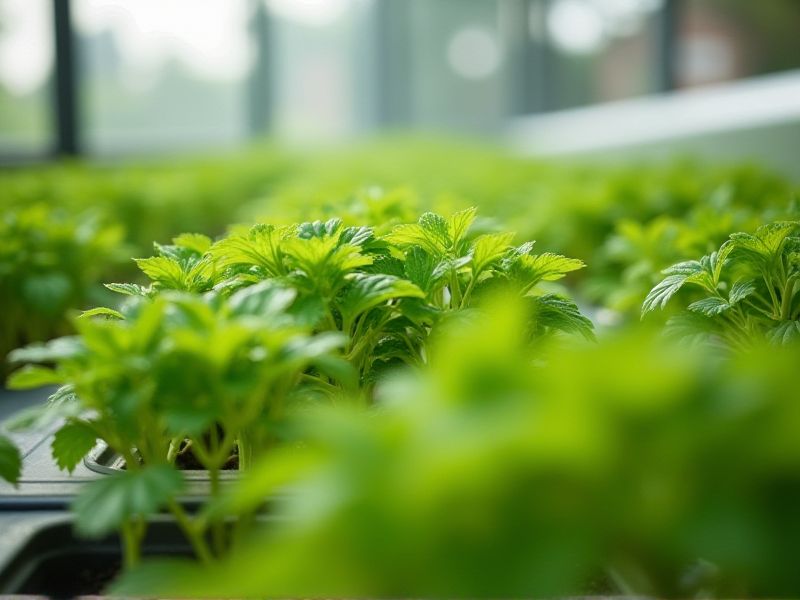
Hydroponic plants thrive in nutrient-rich water solutions, allowing for efficient cultivation without soil. This method enhances crop yield by providing precise control over essential nutrients, oxygen levels, and pH balance. Common hydroponic crops include lettuce, tomatoes, and strawberries, which can grow faster and more abundantly compared to traditional farming. Implementing systems like nutrient film technique (NFT) or deep water culture (DWC) optimizes growth cycles and maximizes space usage. With the growing demand for sustainable farming practices, hydroponics offers a viable solution to produce fresh, healthy crops year-round.
List of some Hydroponic plants that yield crops
- Lettuce (Lactuca sativa)
- Spinach (Spinacia oleracea)
- Basil (Ocimum basilicum)
- Kale (Brassica oleracea)
- Strawberries (Fragaria × ananassa)
- Mint (Mentha spicata)
- Arugula (Eruca vesicaria)
- Tomatoes (Solanum lycopersicum)
- Cucumbers (Cucumis sativus)
- Bell Peppers (Capsicum annuum)
Important things about Hydroponic plants that yield crops
Nutrient Solutions
Nutrient solutions play a crucial role in hydroponic systems, as they supply essential minerals and vitamins required for optimal plant growth. These solutions typically contain macronutrients like nitrogen, phosphorus, and potassium, along with micronutrients such as iron and manganese, all of which directly influence crop yield and quality. By adjusting the nutrient concentration and pH levels, you can enhance plant health and maximize productivity in hydroponic systems. Understanding the specific needs of your crops will enable you to formulate the ideal nutrient mix for flourishing hydroponic gardens.
Water Management
Hydroponic systems allow for precise water management, essential for optimizing crop yield and reducing resource waste. By using nutrient-rich solutions instead of soil, these systems ensure that plants receive the necessary hydration directly to their roots, promoting faster growth and healthier produce. To maximize efficiency, you can implement techniques such as drip irrigation, which minimizes evaporation and runoff, significantly conserving water. Additionally, monitoring water quality and nutrient levels is crucial, as it directly influences the yield of hydroponic crops like lettuce, tomatoes, and herbs.
Light Requirements
Hydroponic plants thrive best under specific light conditions, which significantly influence their growth and crop yield. Most hydroponic systems benefit from full-spectrum LED grow lights, providing both blue light for vegetative growth and red light for flowering and fruiting stages. For optimal growth, aim for 12 to 16 hours of light daily, adjusting based on the specific needs of crops like lettuce, tomatoes, or herbs. Ensuring proper light intensity and duration not only enhances plant health but also maximizes your crop productivity in a hydroponic setup.
Ph Levels
Maintaining the optimal pH levels between 5.5 and 6.5 is crucial for hydroponic plants to thrive and yield abundant crops. pH affects nutrient availability, as certain minerals become more soluble and accessible to plants within this range. Monitoring pH regularly ensures that your plants can absorb necessary nutrients like nitrogen, phosphorus, and potassium efficiently. By utilizing pH management tools, you can enhance plant growth and maximize your hydroponic harvest.
Growing Mediums
Hydroponics utilizes various growing mediums to support plant growth without soil, enabling efficient nutrient absorption. Common mediums include coconut coir, which offers excellent water retention and aeration, and rock wool, known for its sterility and ability to provide adequate support for roots. You might also consider perlite, a volcanic glass that enhances drainage and airflow, promoting healthier root systems. By choosing the right growing medium, you can optimize crop yield while conserving water and nutrients in your hydroponic system.
Pest Control
Hydroponic plants provide an efficient way to grow crops without soil, allowing for controlled nutrient delivery and healthier yields. Common pests affecting hydroponic systems include aphids, spider mites, and whiteflies, which can disrupt growth and reduce crop quality. Utilizing organic pest control methods, such as neem oil and insecticidal soap, can help protect your hydroponic garden while maintaining a healthy ecosystem. Regular monitoring and maintaining optimal environment conditions are crucial for minimizing pest infestations and ensuring robust plant growth.
Variety Selection
When selecting hydroponic plants, consider varieties that thrive in nutrient-rich, soil-less systems for optimal yields. Options like lettuce, basil, and kale not only grow quickly but also adapt well to controlled environments, making them ideal for year-round cultivation. Moreover, fruiting plants such as tomatoes and cucumbers can also be successfully grown hydroponically, providing flavorful produce with a higher density per square foot. By choosing the right varieties, you can maximize your crop yield and enjoy fresh, nutritious produce straight from your hydroponic garden.
System Types
Hydroponic systems, such as deep water culture, nutrient film technique, and aeroponics, are designed for optimal plant growth without soil. These systems utilize a nutrient-rich water solution, providing essential minerals directly to plant roots, which can lead to faster growth and higher yields compared to traditional gardening methods. Regular monitoring of pH and nutrient levels is crucial for success, ensuring that crops like lettuce, tomatoes, and herbs thrive in a controlled environment. With hydroponics, you can maximize space and resources, making it an ideal choice for urban gardening and commercial crop production.
Environmental Control
Hydroponic plants grow in nutrient-rich water solutions instead of soil, promoting faster growth and higher yields due to direct access to essential nutrients. By carefully monitoring variables such as pH levels, light exposure, and temperature, you can create an optimal environment that maximizes crop production. This innovative farming technique enables year-round cultivation, making it possible to produce fresh vegetables and herbs regardless of external weather conditions. Implementing hydroponic systems also reduces water usage by up to 90% compared to traditional agriculture, highlighting its sustainability benefits.
Harvest Timing
Harvest timing for hydroponic plants is crucial for maximizing crop yield and quality. Monitoring factors such as plant growth rate, nutritional content, and environmental conditions will help determine the optimal harvest point. Early harvesting can lead to less mature crops, while delaying harvest may reduce flavor and texture. Using tools like Brix refractometers can assist in assessing fruit sweetness, ensuring you achieve the best taste profile for your hydroponically grown produce.
